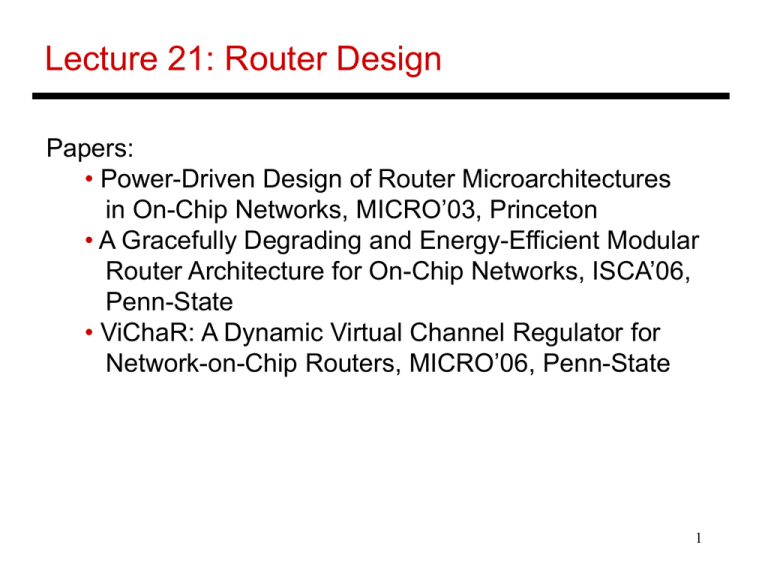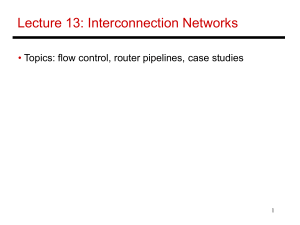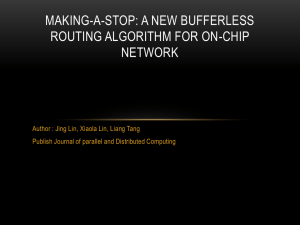Lecture 21: Router Design
advertisement

Lecture 21: Router Design Papers: • Power-Driven Design of Router Microarchitectures in On-Chip Networks, MICRO’03, Princeton • A Gracefully Degrading and Energy-Efficient Modular Router Architecture for On-Chip Networks, ISCA’06, Penn-State • ViChaR: A Dynamic Virtual Channel Regulator for Network-on-Chip Routers, MICRO’06, Penn-State 1 Router Pipeline • Four typical stages: RC routing computation: compute the output channel VA virtual-channel allocation: allocate VC for the head flit SA switch allocation: compete for output physical channel ST switch traversal: transfer data on output physical channel Cycle Head flit Body flit 1 Body flit 2 Tail flit 1 2 3 4 5 6 RC VA SA ST -- --- RC VA SA SA ST SA ST --- STALL 7 -- SA ST -- SA ST -- -- SA ST -- -- -- -- -- SA ST -- SA ST 2 Flow Control • VC allocation: when the tail flit is sent, the router knows that the downstream VC is free (or will soon be); the VC is therefore assigned to the next packet and those flits carry the VCid with them; the two routers need not exchange signals to agree on the VCid • Head-of-Line (HoL) blocking: a flit at the head of the queue blocks flits (belonging to a different packet) behind it that could have progressed… example: if a VC holds multiple packets because the upstream node assumed the previous packet was handled (as above) • Flow control mechanisms: Store-and-Forward: buffers/channels allocated per packet Cut-through: buffers/channels allocated per packet Wormhole: buffers allocated per flit; channels per packet Virtual channel: buffers/channels allocated per flit 3 Data Points • On-chip network’s power contribution in RAW (tiled) processor: 36% in network of compute-bound elements (Intel): 20% in network of storage elements (Intel): 36% bus-based coherence (Kumar et al. ’05): ~12% • Contributors: RAW: links 39%; buffers 31%; crossbar 30% TRIPS: links 31%; buffers 35%; crossbar 33% Intel: links 18%; buffers 38%; crossbar 29%; clock 13% 4 Network Power • Energy for a flit = ER . H + Ewire . D = (Ebuf + Exbar + Earb) . H + Ewire . D ER = router energy H = number of hops Ewire = wire transmission energy D = physical Manhattan distance Ebuf = router buffer energy Exbar = router crossbar energy Earb = router arbiter energy • This paper assumes that Ewire . D is ideal network energy (assuming no change to the application and how it is mapped to physical nodes) • Optimizations are attempted to ER and H 5 Segmented Crossbar • By segmenting the row and column lines, parts of these lines need not switch less switching capacitance (especially if your output and input ports are close to the bottom-left in the figure above) • Need a few additional control signals to activate the tri-state buffers (~2 control signals, ~64 data signals) • Overall crossbar power savings: ~15-30% 6 Cut-Through Crossbar • Attempts to optimize the common case: in dimension-order routing, flits make up to one turn and usually travel straight • 2/3rd the number of tristate buffers and 1/2 the number of data wires • “Straight” traffic does not go thru tristate buffers • Some combinations of turns are not allowed: such as E N and N W (note that such a combination cannot happen with dimension-order routing) • Crossbar energy savings of 39-52%; at full-load, with a worst-case routing algorithm, the probability of a conflict is ~50% 7 Write-Through Input Buffer • Input flits must be buffered in case there is a conflict in a later pipeline stage • If the queue is empty, the input flit can move straight to the next stage: helps avoid the buffer read • To reduce the datapaths, the write bitlines can serve as the bypass path • Power savings are a function of rd/wr energy ratios and probability of finding an empty queue 8 Express Channels • Express channels connect non-adjacent nodes – flits traveling a long distance can use express channels for most of the way and navigate on local channels near the source/destination (like taking the freeway) • Helps reduce the number of hops • The router in each express node is much bigger now 9 Express Channels • Routing: in a ring, there are 5 possible routes and the best is chosen; in a torus, there are 17 possible routes • A large express interval results in fewer savings because fewer messages exercise the express channels 10 Results • Uniform random traffic (synthetic) • Write-thru savings are small • Exp-channel network has half the flit size to maintain the same bisection-bandwidth as other models (express interval of 2) • Baseline model power breakdown: link 44%, crossbar 33%, buffers 23% • Express cubes also improve 0-load latency by 23% -- the others have a negligible impact on performance 11 Conventional Router Slide taken from presentation at OCIN’06 12 The RoCo Router 13 ViChaR • Router buffers are a bottleneck: consume 64% of router leakage power consume up to 46% (54%) of total network power (area) high buffer depth (buffers per VC) prevents a packet from holding resources at multiple routers large number of VCs helps reduce contention under high load • Primary contribution: instead of maintaining k buffers for each of the v virtual channels, maintain a unified storage of vk buffers and allow the number of VCs to dynamically vary between v and vk (buffer depth of k to 1) 14 Proposed Architecture 15 Unified Buffer Design • A table to maintain the buffer entries for each VC • Pointers to the head and tail of each VC • A list of free buffer entries; a list of free VCs (some VCs are used as escape routes to avoid deadlock) • The VCs are allocated in the upstream router – hence, when a VC is freed at a router, the upstream router is informed (this is not done in a conventional router) (process similar to credit flow to estimate buffer occupancy) • Arbitration mechanism so packets can compete for the next channel 16 Results Salient results: • With 16 buffers per input port, ViChaR out-performs the generic router by ~25%, with a 2% power increase • With 8 buffers, ViChaR matches the performance of a 16-buffer generic router, yielding area/power savings of 30%/34% 17 Title • Bullet 18




